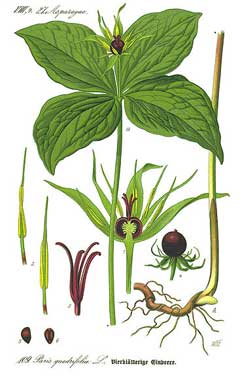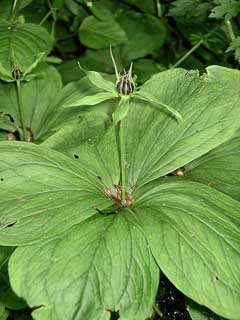 |
|
http://commons.wikimedia.org/wiki/File:Illustration_Paris_quadrifolia0_clean.jpg |
 |
|
Translate this page:
Summary
Physical Characteristics

 Paris_quadrifolia is a PERENNIAL growing to 0.3 m (1ft).
Paris_quadrifolia is a PERENNIAL growing to 0.3 m (1ft).
See above for USDA hardiness. It is hardy to UK zone 6. It is in flower from May to August. The species is hermaphrodite (has both male and female organs) and is pollinated by Flies, midges. The plant is self-fertile.
Suitable for: light (sandy) and medium (loamy) soils. Suitable pH: mildly acid, neutral and basic (mildly alkaline) soils and can grow in very alkaline soils.
It can grow in full shade (deep woodland) or semi-shade (light woodland). It prefers moist soil.
UK Hardiness Map
US Hardiness Map
Synonyms
Plant Habitats
Edible Uses
References More on Edible Uses
Medicinal Uses
Plants For A Future can not take any responsibility for any adverse effects from the use of plants. Always seek advice from a professional before using a plant medicinally.
The entire plant, harvested just as it is coming into flower, is antirheumatic and detergent[13, 61, 178]. In large doses the herb is narcotic, producing nausea, vomiting, vertigo etc[4]. It should be used with great caution, overdoses have proved fatal to children[4]. In small doses it is of benefit in the treatment of bronchitis, spasmodic coughs, rheumatism, colic etc[4]. The plant is also used in the treatment of headaches and neuralgia[61, 178]. The seeds and the berries have something of the nature of opium, they have been used as an aphrodisiac[4]. A tincture of the fresh plant is useful as an antidote to poisoning by mercurial sublimate and arsenic[4]. A cooling ointment made from the seeds and juice of the leaves is applied externally to wounds, tumours and inflammations[4]. The juice of the berries is used to treat eye inflammations[4]. A homeopathic remedy is made from the plant[4].
References More on Medicinal Uses
The Bookshop: Edible Plant Books
Our Latest books on Perennial Plants For Food Forests and Permaculture Gardens in paperback or digital formats.

Edible Tropical Plants
Food Forest Plants for Hotter Conditions: 250+ Plants For Tropical Food Forests & Permaculture Gardens.
More

Edible Temperate Plants
Plants for Your Food Forest: 500 Plants for Temperate Food Forests & Permaculture Gardens.
More

More Books
PFAF have eight books available in paperback and digital formats. Browse the shop for more information.
Shop Now
Other Uses
A red dye is obtained from the berries[13]. A yellow dye is obtained from the leaves[137].
Special Uses
References More on Other Uses
Cultivation details
Easily grown in a humus-rich soil in woodland conditions[200]. Prefers a light sandy loam[42, 90]. Plants are hardy to about -15°c[200]. The presence of this plant in a truly wild state in Britain is an indicator of ancient woodland[200]. Plants are very slow to flower from seed[137]. The flowers are very long-lived[200]. The flowers emit a strong unpleasant smell rather like decaying meat[245].
References Carbon Farming Information and Carbon Sequestration Information
Temperature Converter
Type a value in the Celsius field to convert the value to Fahrenheit:
Fahrenheit:
The PFAF Bookshop
Plants For A Future have a number of books available in paperback and digital form. Book titles include Edible Plants, Edible Perennials, Edible Trees,Edible Shrubs, Woodland Gardening, and Temperate Food Forest Plants. Our new book is Food Forest Plants For Hotter Conditions (Tropical and Sub-Tropical).
Shop Now
Plant Propagation
Seed - best sown as soon as it is ripe in late summer in a cold frame. Sow stored seed in a cold frame as soon as it is received. The seed is very slow to germinate. It produces a primary root about 7 months after sowing, this pulls the seed deeper into the soil. Leaves are produced about 4 months later[137]. Sow the seed thinly so that it does not need to be thinned and grow the young plants on undisturbed in a shady part of the greenhouse for their first two years of growth. Give an occasional liquid feed in the growing season to ensure the plants do not become nutrient deficient. At the end of the second year's growth prick out the young plants into individual pots and grow them on for another year or two in a shady part of the greenhouse before planting them out in the spring. Division.
Other Names
If available other names are mentioned here
Native Range
TEMPERATE ASIA: Russian Federation-Ciscaucasia (Ciscaucasia), Georgia, Russian Federation (Dagestan), Russian Federation-Western Siberia (Western Siberia), Russian Federation-Eastern Siberia (Eastern Siberia) EUROPE: Denmark, Finland, United Kingdom, Iceland, Norway, Sweden, Czechoslovakia, Austria, Belgium, Switzerland, Germany, Hungary, Netherlands, Poland, Russian Federation (European part), Belarus, Russian Federation (Saratov, Volgogradskaja oblast), Ukraine, Former Yugoslavia, Bulgaria, Greece, Italy (incl. Sardinia), Romania, Spain, France (incl. Corsica)
Weed Potential
Right plant wrong place. We are currently updating this section.
Please note that a plant may be invasive in one area but may not in your area so it’s worth checking.
Conservation Status
IUCN Red List of Threatened Plants Status :

Growth: S = slow M = medium F = fast. Soil: L = light (sandy) M = medium H = heavy (clay). pH: A = acid N = neutral B = basic (alkaline). Shade: F = full shade S = semi-shade N = no shade. Moisture: D = dry M = Moist We = wet Wa = water.
Expert comment
Author
L.
Botanical References
17200
Links / References
For a list of references used on this page please go here
Readers comment
© 2010, Plants For A Future. Plants For A Future is a charitable company limited by guarantee, registered in England and Wales. Charity No. 1057719, Company No. 3204567.